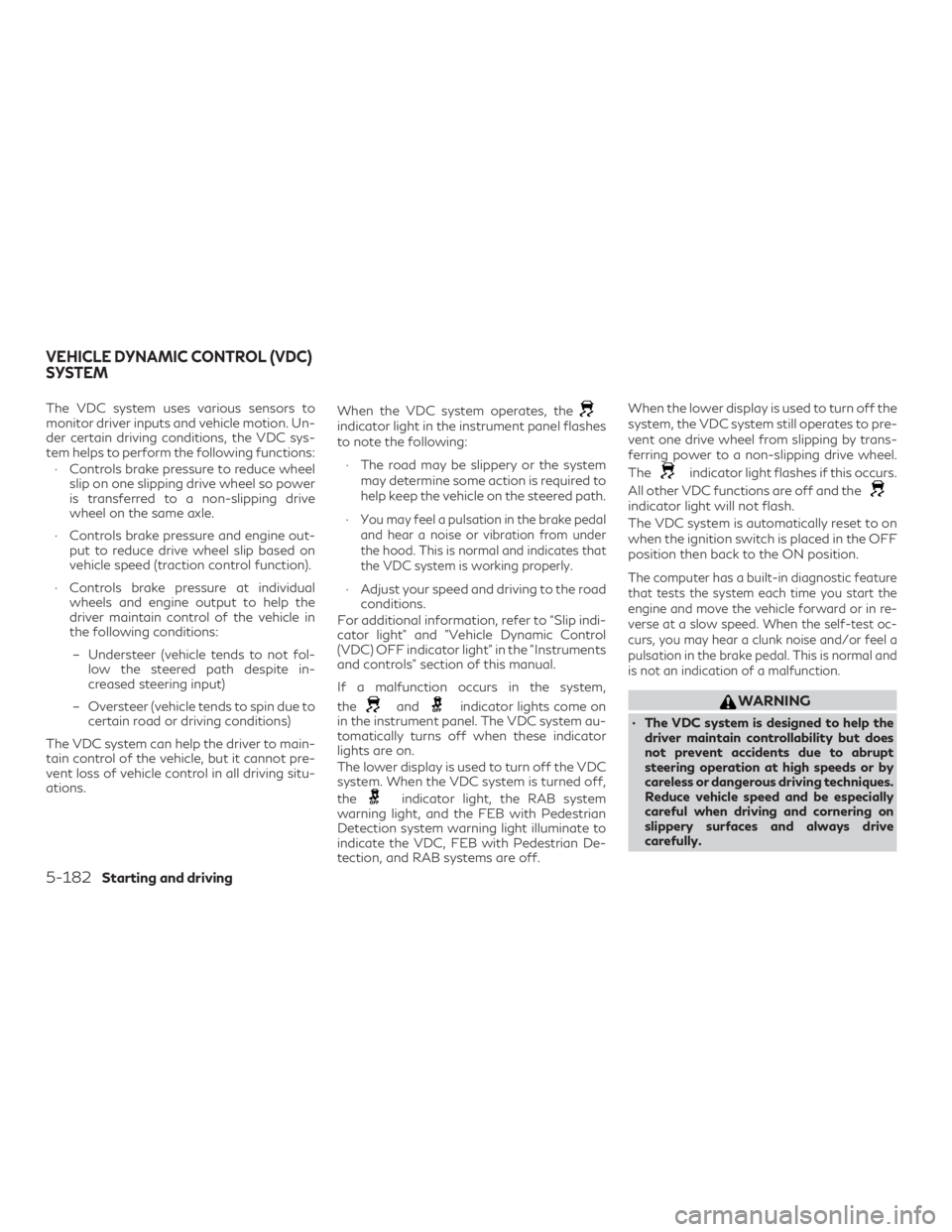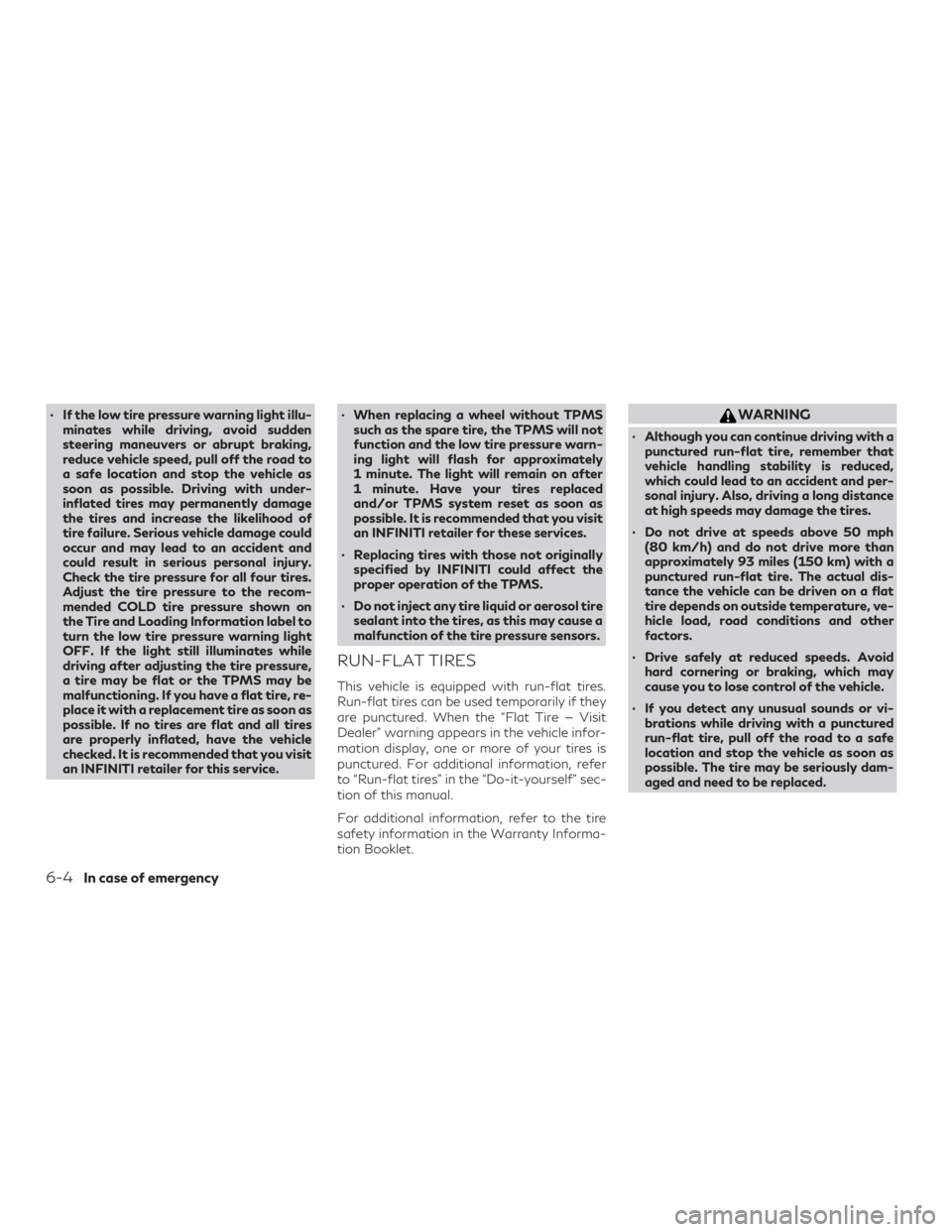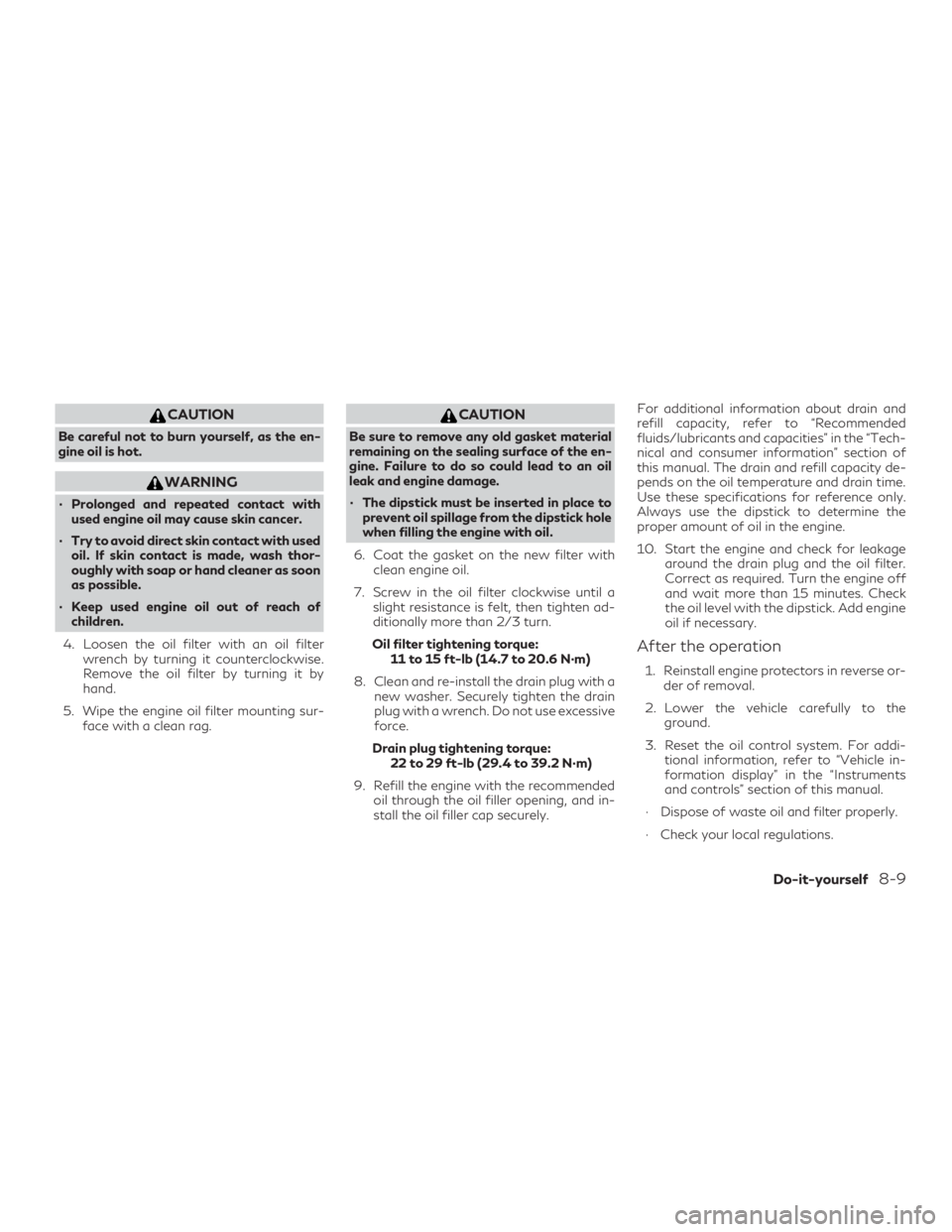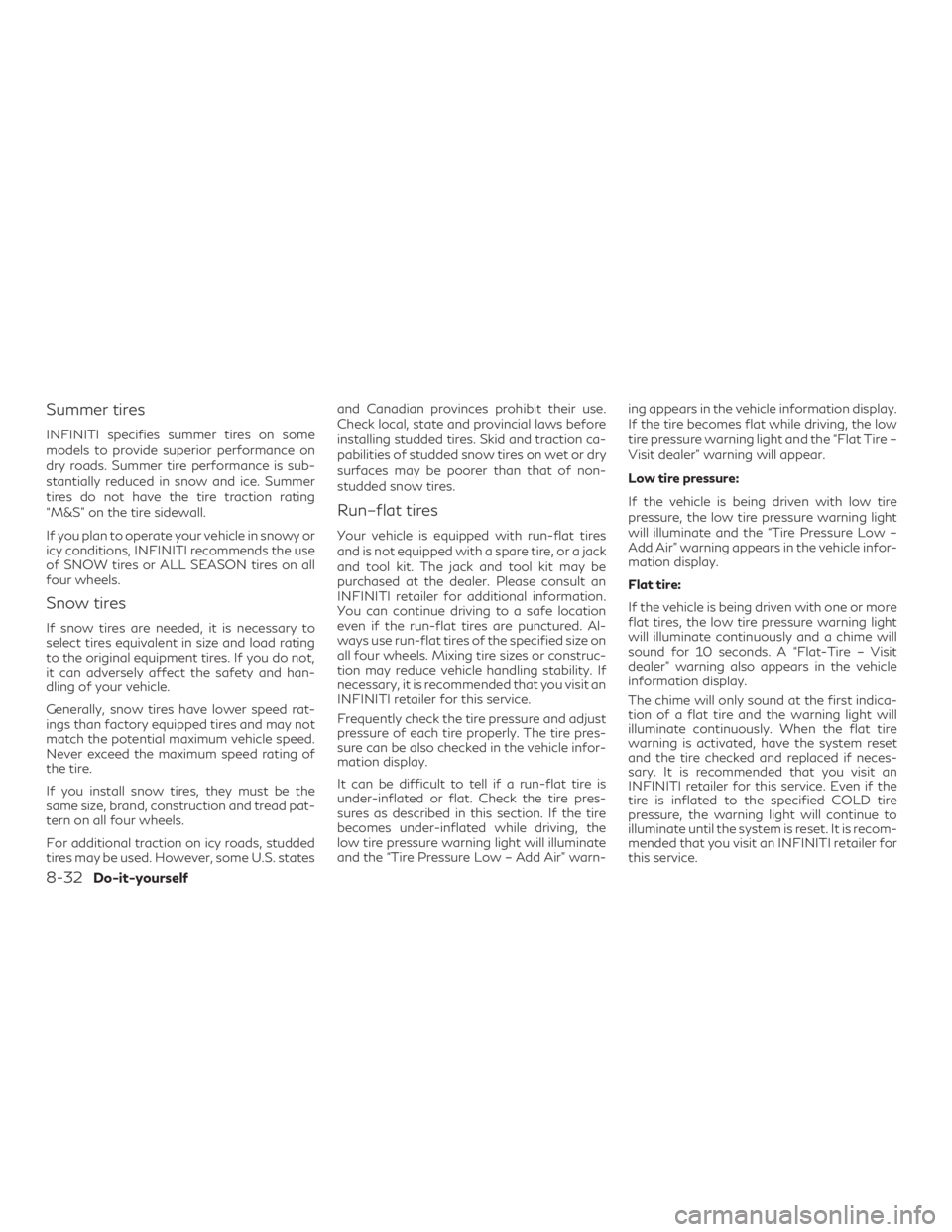reset INFINITI QX50 2020 Owner's Guide
[x] Cancel search | Manufacturer: INFINITI, Model Year: 2020, Model line: QX50, Model: INFINITI QX50 2020Pages: 580, PDF Size: 7.43 MB
Page 395 of 580

To cancel the preset speed, use any of the
following methods:1. Push the CANCEL switch. The vehicle speed indicator will turn off.
2. Tap the brake pedal. The vehicle speed indicator will turn off.
3. Turn the ProPILOT Assist switch off. Both the cruise indicator and vehicle
speed indicator will turn off.
To reset at a faster cruising speed, use one of
the following three methods: 1. Depress the accelerator pedal. When the vehicle attains the desired speed, push
and release the SET- switch.
2. Push and hold the RES+ switch. When the vehicle attains the desired speed, re-
lease the switch.
3. Push, then quickly release the RES+ switch. Each time you do this, the set
speed will increase by about 1 mph
(1 km/h). To reset at a slower cruising speed, use one
of the following three methods:
1. Lightly tap the brake pedal. When the vehicle attains the desired speed, push
the SET- switch and release it.
2. Push and hold the SET- switch. Release the switch when the vehicle slows down
to the desired speed.
3. Push, then quickly release the SET- switch. Each time you do this, the set
speed will decrease by about 1 mph
(1 km/h).
To resume the preset speed, push and release
the RES+ switch. The vehicle will resume the
last set cruising speed when the vehicle speed
is over 25 mph (40 km/h).WARNING
Failure to follow the warnings and instruc-
tions for proper use of the DCA system
could result in serious injury or death.
∙ Always drive carefully and attentively when using the DCA system. Read and
understand the Owner’s Manual thor-
oughly before using the DCA system. To
avoid serious injury or death, do not rely
on the system to prevent accidents or to
control the vehicle’s speed in emergency
situations. Do not use the DCA system
except in appropriate road and traffic
conditions.
∙ The system is only an aid to assist the driver and is not a collision warning or
avoidance device. It is the driver’s re-
sponsibility to stay alert, drive safely and
be in control of the vehicle at all times.
DISTANCE CONTROL ASSIST (DCA)
(if so equipped)
Starting and driving5-133
Page 444 of 580

The VDC system uses various sensors to
monitor driver inputs and vehicle motion. Un-
der certain driving conditions, the VDC sys-
tem helps to perform the following functions:∙ Controls brake pressure to reduce wheel slip on one slipping drive wheel so power
is transferred to a non-slipping drive
wheel on the same axle.
∙ Controls brake pressure and engine out- put to reduce drive wheel slip based on
vehicle speed (traction control function).
∙ Controls brake pressure at individual wheels and engine output to help the
driver maintain control of the vehicle in
the following conditions:
– Understeer (vehicle tends to not fol- low the steered path despite in-
creased steering input)
– Oversteer (vehicle tends to spin due to certain road or driving conditions)
The VDC system can help the driver to main-
tain control of the vehicle, but it cannot pre-
vent loss of vehicle control in all driving situ-
ations. When the VDC system operates, the
indicator light in the instrument panel flashes
to note the following:
∙ The road may be slippery or the system may determine some action is required to
help keep the vehicle on the steered path.
∙
You may feel a pulsation in the brake pedal
and hear a noise or vibration from under
the hood. This is normal and indicates that
the VDC system is working properly.
∙ Adjust your speed and driving to the road conditions.
For additional information, refer to “Slip indi-
cator light” and ”Vehicle Dynamic Control
(VDC) OFF indicator light” in the ”Instruments
and controls” section of this manual.
If a malfunction occurs in the system,
the
andindicator lights come on
in the instrument panel. The VDC system au-
tomatically turns off when these indicator
lights are on.
The lower display is used to turn off the VDC
system. When the VDC system is turned off,
the
indicator light, the RAB system
warning light, and the FEB with Pedestrian
Detection system warning light illuminate to
indicate the VDC, FEB with Pedestrian De-
tection, and RAB systems are off. When the lower display is used to turn off the
system, the VDC system still operates to pre-
vent one drive wheel from slipping by trans-
ferring power to a non-slipping drive wheel.
The
indicator light flashes if this occurs.
All other VDC functions are off and the
indicator light will not flash.
The VDC system is automatically reset to on
when the ignition switch is placed in the OFF
position then back to the ON position.
The computer has a built-in diagnostic feature
that tests the system each time you start the
engine and move the vehicle forward or in re-
verse at a slow speed. When the self-test oc-
curs, you may hear a clunk noise and/or feel a
pulsation in the brake pedal. This is normal and
is not an indication of a malfunction.
WARNING
∙ The VDC system is designed to help the driver maintain controllability but does
not prevent accidents due to abrupt
steering operation at high speeds or by
careless or dangerous driving techniques.
Reduce vehicle speed and be especially
careful when driving and cornering on
slippery surfaces and always drive
carefully.
VEHICLE DYNAMIC CONTROL (VDC)
SYSTEM
5-182Starting and driving
Page 460 of 580

∙ If the low tire pressure warning light illu-minates while driving, avoid sudden
steering maneuvers or abrupt braking,
reduce vehicle speed, pull off the road to
a safe location and stop the vehicle as
soon as possible. Driving with under-
inflated tires may permanently damage
the tires and increase the likelihood of
tire failure. Serious vehicle damage could
occur and may lead to an accident and
could result in serious personal injury.
Check the tire pressure for all four tires.
Adjust the tire pressure to the recom-
mended COLD tire pressure shown on
the Tire and Loading Information label to
turn the low tire pressure warning light
OFF. If the light still illuminates while
driving after adjusting the tire pressure,
a tire may be flat or the TPMS may be
malfunctioning. If you have a flat tire, re-
place it with a replacement tire as soon as
possible. If no tires are flat and all tires
are properly inflated, have the vehicle
checked. It is recommended that you visit
an INFINITI retailer for this service. ∙ When replacing a wheel without TPMS
such as the spare tire, the TPMS will not
function and the low tire pressure warn-
ing light will flash for approximately
1 minute. The light will remain on after
1 minute. Have your tires replaced
and/or TPMS system reset as soon as
possible. It is recommended that you visit
an INFINITI retailer for these services.
∙ Replacing tires with those not originally specified by INFINITI could affect the
proper operation of the TPMS.
∙ Do not inject any tire liquid or aerosol tire sealant into the tires, as this may cause a
malfunction of the tire pressure sensors.
RUN-FLAT TIRES
This vehicle is equipped with run-flat tires.
Run-flat tires can be used temporarily if they
are punctured. When the “Flat Tire — Visit
Dealer” warning appears in the vehicle infor-
mation display, one or more of your tires is
punctured. For additional information, refer
to “Run-flat tires” in the “Do-it-yourself” sec-
tion of this manual.
For additional information, refer to the tire
safety information in the Warranty Informa-
tion Booklet.
WARNING
∙ Although you can continue driving with apunctured run-flat tire, remember that
vehicle handling stability is reduced,
which could lead to an accident and per-
sonal injury. Also, driving a long distance
at high speeds may damage the tires.
∙ Do not drive at speeds above 50 mph (80 km/h) and do not drive more than
approximately 93 miles (150 km) with a
punctured run-flat tire. The actual dis-
tance the vehicle can be driven on a flat
tire depends on outside temperature, ve-
hicle load, road conditions and other
factors.
∙ Drive safely at reduced speeds. Avoid hard cornering or braking, which may
cause you to lose control of the vehicle.
∙ If you detect any unusual sounds or vi- brations while driving with a punctured
run-flat tire, pull off the road to a safe
location and stop the vehicle as soon as
possible. The tire may be seriously dam-
aged and need to be replaced.
6-4In case of emergency
Page 485 of 580

CAUTION
Be careful not to burn yourself, as the en-
gine oil is hot.
WARNING
∙ Prolonged and repeated contact withused engine oil may cause skin cancer.
∙ Try to avoid direct skin contact with used oil. If skin contact is made, wash thor-
oughly with soap or hand cleaner as soon
as possible.
∙ Keep used engine oil out of reach of children.
4. Loosen the oil filter with an oil filter wrench by turning it counterclockwise.
Remove the oil filter by turning it by
hand.
5. Wipe the engine oil filter mounting sur- face with a clean rag.
CAUTION
Be sure to remove any old gasket material
remaining on the sealing surface of the en-
gine. Failure to do so could lead to an oil
leak and engine damage.
∙ The dipstick must be inserted in place toprevent oil spillage from the dipstick hole
when filling the engine with oil.
6. Coat the gasket on the new filter with clean engine oil.
7. Screw in the oil filter clockwise until a slight resistance is felt, then tighten ad-
ditionally more than 2/3 turn.
Oil filter tightening torque: 11 to 15 ft-lb (14.7 to 20.6 N·m)
8. Clean and re-install the drain plug with a new washer. Securely tighten the drain
plug with a wrench. Do not use excessive
force.
Drain plug tightening torque: 22 to 29 ft-lb (29.4 to 39.2 N·m)
9. Refill the engine with the recommended oil through the oil filler opening, and in-
stall the oil filler cap securely. For additional information about drain and
refill capacity, refer to “Recommended
fluids/lubricants and capacities” in the “Tech-
nical and consumer information” section of
this manual. The drain and refill capacity de-
pends on the oil temperature and drain time.
Use these specifications for reference only.
Always use the dipstick to determine the
proper amount of oil in the engine.
10. Start the engine and check for leakage
around the drain plug and the oil filter.
Correct as required. Turn the engine off
and wait more than 15 minutes. Check
the oil level with the dipstick. Add engine
oil if necessary.
After the operation
1. Reinstall engine protectors in reverse or-der of removal.
2. Lower the vehicle carefully to the ground.
3. Reset the oil control system. For addi- tional information, refer to “Vehicle in-
formation display” in the “Instruments
and controls” section of this manual.
∙ Dispose of waste oil and filter properly.
∙ Check your local regulations.
Do-it-yourself8-9
Page 508 of 580

Summer tires
INFINITI specifies summer tires on some
models to provide superior performance on
dry roads. Summer tire performance is sub-
stantially reduced in snow and ice. Summer
tires do not have the tire traction rating
“M&S” on the tire sidewall.
If you plan to operate your vehicle in snowy or
icy conditions, INFINITI recommends the use
of SNOW tires or ALL SEASON tires on all
four wheels.
Snow tires
If snow tires are needed, it is necessary to
select tires equivalent in size and load rating
to the original equipment tires. If you do not,
it can adversely affect the safety and han-
dling of your vehicle.
Generally, snow tires have lower speed rat-
ings than factory equipped tires and may not
match the potential maximum vehicle speed.
Never exceed the maximum speed rating of
the tire.
If you install snow tires, they must be the
same size, brand, construction and tread pat-
tern on all four wheels.
For additional traction on icy roads, studded
tires may be used. However, some U.S. statesand Canadian provinces prohibit their use.
Check local, state and provincial laws before
installing studded tires. Skid and traction ca-
pabilities of studded snow tires on wet or dry
surfaces may be poorer than that of non-
studded snow tires.
Run–flat tires
Your vehicle is equipped with run-flat tires
and is not equipped with a spare tire, or a jack
and tool kit. The jack and tool kit may be
purchased at the dealer. Please consult an
INFINITI retailer for additional information.
You can continue driving to a safe location
even if the run-flat tires are punctured. Al-
ways use run-flat tires of the specified size on
all four wheels. Mixing tire sizes or construc-
tion may reduce vehicle handling stability. If
necessary, it is recommended that you visit an
INFINITI retailer for this service.
Frequently check the tire pressure and adjust
pressure of each tire properly. The tire pres-
sure can be also checked in the vehicle infor-
mation display.
It can be difficult to tell if a run-flat tire is
under-inflated or flat. Check the tire pres-
sures as described in this section. If the tire
becomes under-inflated while driving, the
low tire pressure warning light will illuminate
and the “Tire Pressure Low – Add Air” warn-
ing appears in the vehicle information display.
If the tire becomes flat while driving, the low
tire pressure warning light and the “Flat Tire –
Visit dealer" warning will appear.
Low tire pressure:
If the vehicle is being driven with low tire
pressure, the low tire pressure warning light
will illuminate and the “Tire Pressure Low –
Add Air” warning appears in the vehicle infor-
mation display.
Flat tire:
If the vehicle is being driven with one or more
flat tires, the low tire pressure warning light
will illuminate continuously and a chime will
sound for 10 seconds. A “Flat-Tire – Visit
dealer" warning also appears in the vehicle
information display.
The chime will only sound at the first indica-
tion of a flat tire and the warning light will
illuminate continuously. When the flat tire
warning is activated, have the system reset
and the tire checked and replaced if neces-
sary. It is recommended that you visit an
INFINITI retailer for this service. Even if the
tire is inflated to the specified COLD tire
pressure, the warning light will continue to
illuminate until the system is reset. It is recom-
mended that you visit an INFINITI retailer for
this service.
8-32Do-it-yourself
Page 512 of 580

Replacing wheels and tires
When replacing a tire, use the same size,
tread design, speed rating and load carrying
capacity as originally equipped. For addi-
tional information, refer to “Wheels and tires”
in the “Technical and consumer information”
section of this manual.
WARNING
∙ The use of tires other than those recom-mended or the mixed use of tires of dif-
ferent brands, construction (bias, bias-
belted or radial), or tread patterns can
adversely affect the ride, braking, han-
dling, VDC system, ground clearance,
body-to-tire clearance, tire chain clear-
ance, speedometer calibration, headlight
aim and bumper height. Some of these
effects may lead to accidents and could
result in serious personal injury.
∙ For 2WD models, if your vehicle was originally equipped with four tires that
were the same size and you are only re-
placing two of the four tires, install the
new tires on the rear axle. Placing new
tires on the front axle may cause loss of
vehicle control in some driving conditions
and cause an accident and personal
injury. ∙ If the wheels are changed for any reason,
always replace with wheels which have
the same off-set dimension. Wheels of a
different off-set could cause premature
tire wear, degrade vehicle handling char-
acteristics, affect the VDC system
and/or interference with the brake discs.
Such interference can lead to decreased
braking efficiency and/or early brake
pad wear. For additional information on
wheel off-set dimensions, refer to
“Wheels and tires” in the “Technical and
consumer information” section of this
manual.
∙ When replacing a wheel without the TPMS, such as the spare tire, the TPMS
will not function and the low tire pressure
warning light will flash for approximately
1 minute. The light will remain on after
1 minute. Have your tires replaced
and/or TPMS system reset as soon as
possible. It is recommended that you visit
an INFINITI retailer for this service.
∙ Replacing tires with those not originally specified by INFINITI could affect the
proper operation of the TPMS.
∙ The TPMS sensor may be damaged if it is not handled correctly. Be careful when
handling the TPMS sensor. ∙ When replacing the TPMS sensor, the ID
registration may be required. It is recom-
mended that you visit an INFINITI re-
tailer for ID registration.
∙ Do not use a valve stem cap that is not specified by INFINITI. The valve stem cap
may become stuck.
∙ Be sure that the valve stem caps are cor- rectly fitted. Otherwise the valve may be
clogged up with dirt and cause a malfunc-
tion or loss of pressure.
∙ Do not install a damaged or deformed wheel or tire even if it has been repaired.
Such wheels or tires could have structural
damage and could fail without warning.
∙ The use of retread tires is not recommended.
∙ For additional information regarding tires, refer to “Important Tire Safety In-
formation” (US) or “Tire Safety Informa-
tion” (Canada) in the Warranty Informa-
tion Booklet.
Wheel balance
Unbalanced wheels may affect vehicle han-
dling and tire life. Even with regular use,
wheels can get out of balance. Therefore,
they should be balanced as required.
8-36Do-it-yourself
Page 522 of 580

How driving conditions affect OCS display
timing
ConditionsDriving Scene Display timing
Light ∙ Freeway driving
∙ City driving (flat/moderate hills)
∙ No towing or heavy loads
∙ No extended engine idling Normal
Extreme ∙ Repeated short trips of less than 5 miles (8 km).
∙ Repeated short trips of less than 10 miles (16 km) with outside temperatures remaining below
freezing.
∙ Operating in hot weather in stop-and-go “rush hour” traffic.
∙ Extensive idling and/or low speed driving for long distances, such as police, taxi or door-to-
door delivery use.
∙ Towing a trailer or caravan, or using a car-top carrier.
∙ Driving with frequent use of braking or in mountainous areas.
∙ Sustained high speed driving. Early
CAUTION
∙ If the oil replacement indicator is dis-
played, change the engine oil within two
weeks or less than 500 miles (800 km).
∙ Operating your vehicle with deteriorated oil can damage the engine.
∙ If your oil replacement indicator resets prematurely or becomes inoperative,
please change the oil within six months or
3,750 miles (6,000 km) from your last oil
change.
9-8Maintenance and schedules
Page 561 of 580

You may notify INFINITI by contacting
our Consumer Affairs Department,
toll-free, at 1-800-662-6200.
For Canada
If you believe that your vehicle has a
defect which could cause a crash or
could cause injury or death, you should
immediately inform Transport Canada
in addition to notifying INFINITI.
If Transport Canada receives com-
plaints, it may open an investigation,
and if it finds that a safety defect ex-
ists in a group of vehicles, it may re-
quest that INFINITI conduct a recall
campaign. However, Transport
Canada cannot become involved in in-
dividual problems between you, your
retailer, or INFINITI.
You may contact Transport Canada’s
Defect Investigations and Recalls Divi-
sion toll free at 1-800-333-0510. You
may also report safety defects online
at: https://wwwapps.tc.gc.ca/Saf-
Sec-Sur/7/PCDB-BDPP/fc-
cp.aspx?lang=eng (English speakers) orhttps://wwwapps.tc.gc.ca/Saf-Sec-
Sur/7/PCDB-BDPP/fc-
cp.aspx?lang=fra (French speakers)
Additional information concerning mo-
tor vehicle safety may be obtained from
Transport Canada’s Road Safety Infor-
mation Centre at 1-800-333-0371 or
online at www.tc.gc.ca/roadsafety
(English speakers) or
www.tc.gc.ca/securiteroutiere (French
speakers).
To notify INFINITI of any safety con-
cerns please contact our Consumer In-
formation Centre toll free at 1-800-
361-4792.
WARNING
A vehicle equipped with All-Wheel Drive
(AWD) should never be tested using a two
wheel dynamometer (such as the dyna-
mometers used by some states for emis-
sions testing), or similar equipment. Make
sure you inform the test facility personnel
that your vehicle is equipped with AWD be-
fore it is placed on a dynamometer. Using
the wrong test equipment may result in
transmission damage or unexpected vehicle
movement which could result in serious ve-
hicle damage or personal injury.
Due to legal requirements in some states and
Canadian Provinces, your vehicle may be re-
quired to be in what is called the “ready con-
dition” for an Inspection/Maintenance (I/M)
test of the emission control system.
The vehicle is set to the “ready condition”
when it is driven through certain driving pat-
terns. Usually, the ready condition can be
obtained by ordinary usage of the vehicle.
If a powertrain system component is repaired
or the battery is disconnected, the vehicle
may be reset to a “not ready” condition. Be-
fore taking the I/M test, check the vehicle’s
inspection/maintenance test readiness con-
dition. Place the ignition switch in the ON
position without starting the engine. If the
READINESS FOR INSPECTION/
MAINTENANCE (I/M) TEST
Technical and consumer information10-31